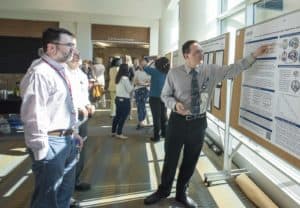UAMS Showcase of Medical Discoveries Celebrates Garcia-Rill Legacy
| The UAMS Showcase of Medical Discoveries on May 15 was a celebration of UAMS’ first Center of Biomedical Research Excellence (COBRE), which brought in more than $21 million in research

Andrew James, Ph.D., explains his brain imaging research as part of a study related to a potential noninvasive therapy for tinnitus.
funding to UAMS over the last 15 years.
UAMS’ Edgar Garcia-Rill, Ph.D., secured the COBRE funding to establish the Center for Translational Neuroscience (CTN). The program expires this year, although it lives on through the research programs it helped sprout.
The center has helped jump-start the careers of numerous UAMS researchers through its pilot research grants and mentoring of new researchers. The COBRE funds have helped generate a 6-to-1 return on investment; 36 researchers have leveraged the pilot funding to acquire more than $120 million in funding from outside UAMS.
Alison Oliveto, Ph.D., said she and other UAMS researchers were talking about how to celebrate the CTN and pitched a showcase of the CTN-supported research.
“It seemed like a great opportunity to showcase some of his impact, including posters showing just how amazing the COBRE has been for UAMS,” said Oliveto, professor and vice chair for research in the Department of Psychiatry and Behavioral Sciences in the UAMS College of Medicine. “He pioneered this. It was the first COBRE ever at UAMS, and look at what it’s done.”
Among the many success stories at the showcase was Whit Hall, M.D., whose CTN-funded research demonstrated that telemedince – interactive video consultations with hospital nursery physicians in Arkansas – could reduce the state’s infant mortality rate.
Hall leads the educational and consultation program for rural hospital nurseries called PedsPLACE and Telenursery, which have saved about 60 babies per year since 2009. As a result, Arkansas Medicaid will fund the program in perpetuity. The National Institutes of Health (NIH) also views it as a model for other states, and Hall is involved in efforts to expand the program into Mississippi and Alabama.
“The PedsPLACE program never would have been possible without Dr. Garci-Rill’s vision and leadership to acquire the COBRE,” said Hall, a neonatologist and professor in the Department of Pediatrics, College of Medicine.
“The CTN has really helped spur my research on and has allowed me to leverage bigger grants as well as at least 50 publications,” he said.
The showcase is sponsored by the UAMS Vice Chancellor for Research, Shuk-Mei Ho, Ph.D.
In her remarks, Ho congratulated Garcia-Rill on the legacy he is leaving at UAMS and nationally. She noted the impressive display of plaques outside his office with names of the dozens of researcher trainees who have benefited from the CTN and Garcia-Rill’s mentorship. Many have become successful researchers at UAMS and other institutions.
Garcia-Rill, she added, demonstrated a knack for promoting multi-disciplinary research. For example, he has contributed to the use of brain research in legal policymaking, referencing a series of law reviews that he wrote called “The Law and the Brain.”
“You are truly a scholar,” she said.
UAMS Graduate School Dean Robert E. McGehee, Ph.D., said the CTN created a rich training ground for his graduate students, directly mentoring 18 Ph.D. graduates and two M.S. graduates.
“It has been the single most successful center or training grant for Ph.D. graduates in the last 20 years,” McGehee said. “Importantly, these graduates have gone on to a variety of successful careers both in Arkansas and across the state. Several went to medical school, others to faculty positions including University of Pittsburgh, Emory University, Mt. Sinai, Southern Arkansas University, University of Central Arkansas and UAMS, while others went to national labs. It is quite a legacy.”
